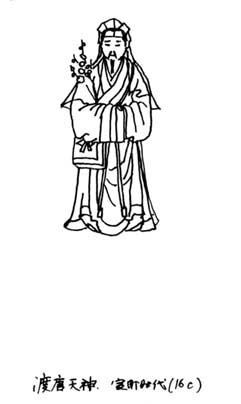|
||
 |
||

@
(C)2001 Japanese Architecture and Art Net Users System.@No reproduction or republication without written permission.
fΪΜeLXgEΚ^ECXgΘΗASΔΜRecΜ³f‘»E]ΪπΦΆά·B
|
||||||
| @ | ||||||
| Totou Tenjin@nV_ | ||||||
| KEY WORD :@art history / iconography | ||||||
| @ | ||||||
| Tenjin crossing to China. The Heian period courtier, poet, and scholar Sugawara Michizane ΄Ή^ (845-903) was deified as the Shinto god *Tenjin V_ soon after his death in exile at Dazaifu ΎΙ{, northern Kyuushuu γB, see *Kitano tenjin engi kμV_N. Worshipped by courtiers as a god of poetry, calligraphy, and scholarship, the cult of Tenjin eventually spread to Buddhism where he was thought to be a reincarnation of the Bodhisattva *Kannon ΟΉ. By the late 14c, a story concerning Tenjin circulated widely in the Japanese Zen T community. According to the legend, Tenjin appeared in a dream of Enni Ben'en ~’Ω~ (1202-80), the founder of Toufukuji , soon after his return from China. Tenjin asked the monk to recommend a Chinese Zen teacher, and Enni suggested his own master Wuzhun Shifan (Jp: Bujun Shiban ³tΝ, also read Mujun Shihan, 1177-1249). Later, Tenjin appeared again to report that he had indeed received Wuzhun's teaching and, as certification, a monk's robe. The interest in Tenjin by the Zen community is probably related to the monks' fascination with Chinese literature, particularly the poet *So Touba h± (1036-1101), and Tenjin's reputation as the foremost Japanese master of Chinese verse. During the early Muromachi period, painting of Tenjin dressed in Chinese scholar's robes, were produced in great numbers. Typically, the paintings show Teinjin standing frontally against a neutral background, and often include a poetic inscription. The theme was a favorite of the early 17c courtier Konoe Nobutada ίqM (1565-1614) who painted distinctive images of Totou Tenjin with a minimum of thick ink strokes. | ||||||
| @ | ||||||
 |
||||||
@ |
||||||
| REFERENCES: | ||||||
| @ | ||||||
| EXTERNAL LINKS: | ||||||
| @@ | ||||||
| NOTES: | ||||||
| @ | ||||||
(C)2001 Japanese Architecture and Art Net Users System.@No reproduction or republication without written permission. fΪΜeLXgEΚ^ECXgΘΗASΔΜRecΜ³f‘»E]ΪπΦΆά·B |
||||||
| @ |